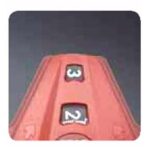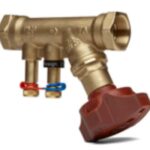 Having a general understanding of flow devices or balancing valves is important for the Owners, Architects, Engineers, and Mechanical Contractors. Simply put, it is specified and installed to set a flow (gpm) to a predetermined value, which is best determined by utilizing a digital hydronic meter to measure a pressure drop. This pressure drop is correlated to the manufacturer’s information; i.e., flow wheels, charts, etc. Many of the flow devices have a handle with a numbering system, (as indicated in picture) which allows a TAB Technician to correlate the hand wheel setting and pressure drop across the flow device. With this information, the TAB Technician now has determined the gpm (flow) and can make any adjustments.
Having a general understanding of flow devices or balancing valves is important for the Owners, Architects, Engineers, and Mechanical Contractors. Simply put, it is specified and installed to set a flow (gpm) to a predetermined value, which is best determined by utilizing a digital hydronic meter to measure a pressure drop. This pressure drop is correlated to the manufacturer’s information; i.e., flow wheels, charts, etc. Many of the flow devices have a handle with a numbering system, (as indicated in picture) which allows a TAB Technician to correlate the hand wheel setting and pressure drop across the flow device. With this information, the TAB Technician now has determined the gpm (flow) and can make any adjustments.
 Now comes the Twist. SITA and SITACx were recently contracted to review a two-year old project. This building addition had severe temperature and humidity problems. (Just a note, we were not the original TAB firm.) During our investigation, one of the major issues—there were a few others—was incorrectly set flow devices. During the review and testing of the flow devices, as well as utilizing an UltraSonic Meter, SITA and SITACx determined that the hand wheels were initially set up improperly and the chilled water coils were approximately 20% of the required flow; thus, temperature and humidity issues occurred. The hand wheels must be reviewed by the TAB Technician and Mechanical Contractor to ensure the flow device opens to the correct maximum setting, which the original TAB firm did not do. The correct method will require the TAB Technician to remove the hand wheel and reset the numbering accordingly (refer to product instructions); now the flow device can be balanced. The original TAB firm, believing they had the correct flow, appear to have inserted coil temperatures which were not actual temperatures, thus masking the problem.
Now comes the Twist. SITA and SITACx were recently contracted to review a two-year old project. This building addition had severe temperature and humidity problems. (Just a note, we were not the original TAB firm.) During our investigation, one of the major issues—there were a few others—was incorrectly set flow devices. During the review and testing of the flow devices, as well as utilizing an UltraSonic Meter, SITA and SITACx determined that the hand wheels were initially set up improperly and the chilled water coils were approximately 20% of the required flow; thus, temperature and humidity issues occurred. The hand wheels must be reviewed by the TAB Technician and Mechanical Contractor to ensure the flow device opens to the correct maximum setting, which the original TAB firm did not do. The correct method will require the TAB Technician to remove the hand wheel and reset the numbering accordingly (refer to product instructions); now the flow device can be balanced. The original TAB firm, believing they had the correct flow, appear to have inserted coil temperatures which were not actual temperatures, thus masking the problem.
The directions all TAB firms must follow are:
- Request and review product submittal data and operational information.
- Upon completion of setting coil gpm, actual temperatures are to be obtained. From the coil temperatures, calculate gpm and btu to compare to design.
These steps of testing are NEBB and AABC standards, which is why all field technicians must utilize flow device data sheets and coil performance test sheets.
